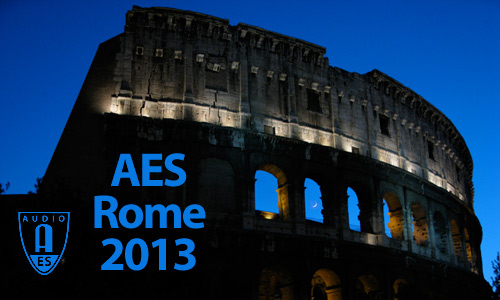
AES Rome 2013
Paper Session P2
P2 - Audio Signal Processing—Part 1
Saturday, May 4, 10:30 — 12:30 (Sala Foscolo)
Chair:
Danilo Comminiello, Sapienza University of Rome - Rome, Italy
P2-1 Loudness Measurement of Multitrack Audio Content Using Modifications of ITU-R BS.1770—Pedro Duarte Pestana, Research Center for Science and Technology of the Arts, Portguese Catholic University (CITAR-UCP) - Almada, Portugal; CEAUL-FCUL; Joshua D. Reiss, Queen Mary University of London - London, UK; Alvaro Barbosa, Research Center for Science and Technology of the Arts, Portguese Catholic University (CITAR-UCP) - Lisbon, Portugal
The recent loudness measurement recommendations by the ITU and the EBU have gained widespread recognition in the broadcast community. The material it deals with is usually full-range mastered audio content, and its applicability to multitrack material is not yet clear. In the present work we investigate how well the evaluated perception of single track loudness agrees with the measured value as defined by ITU-R BS.1770. We analyze the underlying features that may be the cause for this disparity and propose some parameter alterations that might yield better results for multitrack material with minimal modification to their rating of broadcast content. The best parameter sets are then evaluated by a panel of experts in terms of how well they produce an equal-loudness multitrack mix and are shown to be significantly more successful.
Convention Paper 8813 (Purchase now)
P2-2 Delayless Robust DPCM Audio Transmission for Digital Wireless Microphones—Florian Pflug, Technische Universität Braunschweig - Braunschweig, Germany; Tim Fingscheidt, Technische Universität Braunschweig - Braunschweig, Germany
The employment of digital wireless microphones in professional contexts requires ultra-low delay, strong robustness, and high audio quality. On the other hand, audio coding is required in order to comply with the restrictions on the bandwidth of the radio channel, making the resulting source-coded audio signal more vulnerable to channel distortions. Therefore, in this paper we present a transmission system for differential pulse-code modulated (DPCM) audio with receiver-sided soft-decision error concealment exploiting channel reliability information, explicit redundancy by simple delayless parity-check codes, and residual redundancy within the source-coded audio signal. Simulations on frequency-shift keying (FSK)-modulated channels with additive white Gaussian noise show considerable gains in audio quality compared to hard-decision decoding and soft-decision decoding only exploiting reliability information and 0th-order a priori knowledge.
Convention Paper 8814 (Purchase now)
P2-3 Violin Sound Computer Classification Based on Expert Knowledge—Adam Robak, Poznan University of Technology - Poznan, Poland; Ewa Lukasik, Poznan University of Technology - Poznan, Poland
The paper presents results of the analysis of violins recorded during the final stage of the international violin-makers competition held in Poznan in 2011. In the quest for attributes that are both efficient for machine learning and interpretable for human experts we referred to the research of violin acousticians: Duennwald, Buen, and Fritz and calculated violin sound power in frequency bands recommended by these researchers. The resulting features, obtained for the averaged spectra of the musical pieces played at the competition, were used for clustering and classification experiments. Results are discussed, and a notable experiment is presented where the classifier assigns each analyzed violin to an instrument from the precedent violinmakers’ competition (2001) and compares their ranking.
Convention Paper 8815 (Purchase now)
P2-4 A Finite Difference Method for the Excitation of a Digital Waveguide String Model—Leonardo Gabrielli, Universitá Politecnica delle Marche - Ancona, Italy; Luca Remaggi, Universitá Politecnica delle Marche - Ancona, Italy; Stefano Squartini, Università Politecnica delle Marche - Ancona, Italy; Vesa Välimäki, Aalto University - Espoo, Finland
With Digital Waveguide modeling (DWG) a number of excitation methods have been proposed to feed the delay line properly. Generally speaking these may be based on signal models fitting recorded samples, excitation signals extracted from recorded samples or digital filter networks. While allowing for a stable, computationally efficient sound emulation, they may be unable to emulate secondary effects generated by the physical interaction of, e.g., distributed interaction of string and hammer. On the other hand, FDTD (Finite Difference Time Domain) models are more accurate in the emulation of the physical excitation mechanism at the expense of a higher computational cost and a complex coefficient design to ensure numerical stability. In this paper a mixed model is proposed composed of a two-step FDTD model, a commuted DWG, and an adaptor block to join the two sections. Properties of the model are provided and computer results are given for the case of the Clavinet tangent-string mechanism as an example application.
Convention Paper 8816 (Purchase now)
